RESEARCH
THERMAL EVOLUTION OF PLANETARY INTERIORS
Mars – Strongly magnetized crust discovered by the Mars Global Surveyor (MGS) magnetometer experiment revealed that Mars had a global magnetic field driven by an early core dynamo, like the Earth, during the first 500 million years after the planet formed. A core dynamo is generated by electromagnetic induction where electric currents are induced by the motion of a conducting fluid moving through a magnetic field. The currents in turn generate a magnetic field. A convecting liquid iron-rich core of a planet can therefore generate a magnetic field. Francis Nimmo (UCSC) and I have developed a planetary thermal evolution model to understand how Mars could have generated an early dynamo. Details of this work can be found in a conference poster presented at the 6th Internation Conference on Mars in Pasadena, CA and our paper published in the journal Geology.
Mercury – Although the smallest planet in our solar system, it is one of the more enigmatic planets. Its radius is only 1.4× bigger than our Moon making it smaller than Ganymede and Titan, the largest moons of Jupiter and Saturn, yet it it has the largest fractional core size of any planet inferred from its very high density. One of the more interesting observations of the planet is that it possesses a global magnetic field. First observed by the Mariner 10 spacecraft in the 70's and now confirmed by the MESSENGER spacecraft currently orbiting Mercury, it remains to be adequately explained how the planet is generating a magnetic field. We have applied the planetary thermal evolution model to Mercury demonstrating the difficulty in explaining the planet's a magnetic field. Details of this work can be read in this paper published in the journal Geophysical Research Letters.
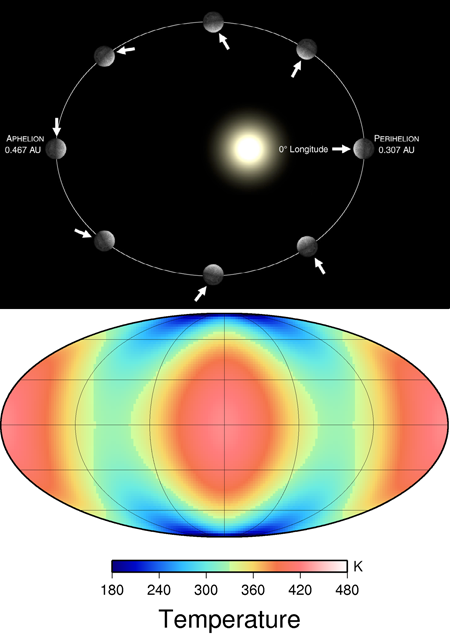 The planet is also locked in a unique 3:2 spin-orbit resonance making three rotations about
its spin axis (sidereal days) every two orbits about the Sun. As a result, one solar day,
takes two Mercury years and the sun is always overhead (noon local time) at perihilion
(closest to the sun) at 0° and 180° longitude, and aphelion (farthest from the sun)
at 90° and 270°. The fairly high eccentricity of the orbit means the insolation
(a measure of solar radiation energy) varies between 14,464 and 6279 W m-2,
a variation 6× that of the average insolation at the Earth (1361 W m-2).
This results in annual average surface temepratures that are not only latitude dependent,
as we observe on Earth where the equator is hot and the polar regions are cold, but
longitude dependent as seen in the figure.
Average temperatures at the equator vary between
about 57 °C and 157 °C (135 °F and 315 °F), a difference of
about 100 °C (212 °F), the temperature difference between the freezing point
and boiling point of water. We explore the consequences of this temperature
difference on the heat flow and strength of the planet's lithosphere. The lithosphere
is the rigid, strong outer portion of the planet. We find that the surface temperature
variations are large enough to influence the strength of the lithosphere. Details of this
work and the geophysical consequences can be read in our
paper published in the
Journal of Geophysical Research.
The planet is also locked in a unique 3:2 spin-orbit resonance making three rotations about
its spin axis (sidereal days) every two orbits about the Sun. As a result, one solar day,
takes two Mercury years and the sun is always overhead (noon local time) at perihilion
(closest to the sun) at 0° and 180° longitude, and aphelion (farthest from the sun)
at 90° and 270°. The fairly high eccentricity of the orbit means the insolation
(a measure of solar radiation energy) varies between 14,464 and 6279 W m-2,
a variation 6× that of the average insolation at the Earth (1361 W m-2).
This results in annual average surface temepratures that are not only latitude dependent,
as we observe on Earth where the equator is hot and the polar regions are cold, but
longitude dependent as seen in the figure.
Average temperatures at the equator vary between
about 57 °C and 157 °C (135 °F and 315 °F), a difference of
about 100 °C (212 °F), the temperature difference between the freezing point
and boiling point of water. We explore the consequences of this temperature
difference on the heat flow and strength of the planet's lithosphere. The lithosphere
is the rigid, strong outer portion of the planet. We find that the surface temperature
variations are large enough to influence the strength of the lithosphere. Details of this
work and the geophysical consequences can be read in our
paper published in the
Journal of Geophysical Research.
TOPOGRAPHY AND GRAVITY OF MARS
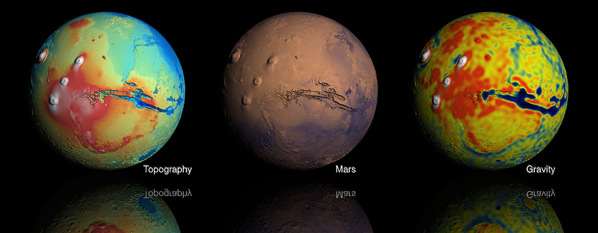
The topography and gravity of a planet can be used to infer internal
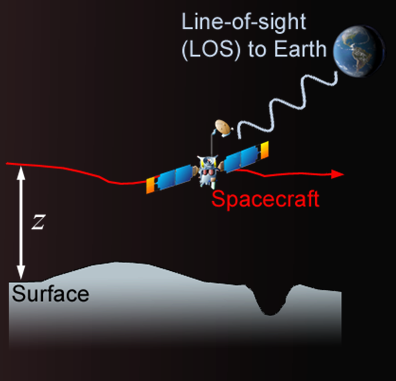 structure, for example the thickness of the crust, or the compensation state of topography.
The topography of Mars has been determined by the Mars Orbiter Laser Altmeter
(MOLA) instrument on the Mars
Global Surveyor
(MGS).
The laser altimeter works by measuring the time a pulse of light takes to leave
the spacecraft, reflect off the surface, and return to MOLA's collecting mirror.
structure, for example the thickness of the crust, or the compensation state of topography.
The topography of Mars has been determined by the Mars Orbiter Laser Altmeter
(MOLA) instrument on the Mars
Global Surveyor
(MGS).
The laser altimeter works by measuring the time a pulse of light takes to leave
the spacecraft, reflect off the surface, and return to MOLA's collecting mirror.
Variations in the surface gravity beneath orbiting spacecraft cause slight variation in orbit velocities. These small accelerations of the spacecraft result in doppler shifts in the radio signals to Earth. From these doppler shifts, the line-of-sight velocity changes can be estimated. With enough observations, these accelerations are used to reconstruct the gravity field of the planet.
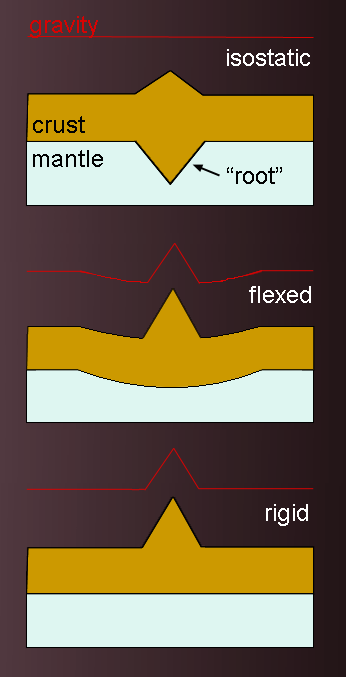 Topography can be supported by the strength of the rigid, outer part of the planet,
called the lithosphere, and by buoyant forces as the crust is less dense than the
underlying mantle (analogous to an iceburg). How much strength the lithosphere has
to help support topography depends on the length of the feature. Shorter features
are generaly supported entirely by the lithosphere and the extra mass of the topography
creates a positive gravity anomoly. Longer features can not be supported by the strength of
the lithosphere and are buoyantly supported. The topography is then compensated by a
crustal "root" in the mantle and the mass of the topography is balanced by the downward
deflection of the bottom of the crust (Moho). This wavelength dependence of compensation
can be modeled as flexure of an elastic plate or shell and the wavelength at which
the compenstation transitions between elastic compensation to buoyant compenstation,
tells us something about the heat flow from the interior as high heat
flow results in weaker lithosphere. This flexural response to topographic loads changes
over time. As a planet's interior cools, and heat flow
is reduced, the lithosphere generally strengthens. Gravity as
a function of wavelength contains information on how topography is supported and tell us
something about the planet's heat flow at the time a topographic feature formed.
Details of my work analysis gravity and topography can be read in my
paper published in the
Journal of Geophysical Research.
Topography can be supported by the strength of the rigid, outer part of the planet,
called the lithosphere, and by buoyant forces as the crust is less dense than the
underlying mantle (analogous to an iceburg). How much strength the lithosphere has
to help support topography depends on the length of the feature. Shorter features
are generaly supported entirely by the lithosphere and the extra mass of the topography
creates a positive gravity anomoly. Longer features can not be supported by the strength of
the lithosphere and are buoyantly supported. The topography is then compensated by a
crustal "root" in the mantle and the mass of the topography is balanced by the downward
deflection of the bottom of the crust (Moho). This wavelength dependence of compensation
can be modeled as flexure of an elastic plate or shell and the wavelength at which
the compenstation transitions between elastic compensation to buoyant compenstation,
tells us something about the heat flow from the interior as high heat
flow results in weaker lithosphere. This flexural response to topographic loads changes
over time. As a planet's interior cools, and heat flow
is reduced, the lithosphere generally strengthens. Gravity as
a function of wavelength contains information on how topography is supported and tell us
something about the planet's heat flow at the time a topographic feature formed.
Details of my work analysis gravity and topography can be read in my
paper published in the
Journal of Geophysical Research.
 Home
Home Research
Research Publications
Publications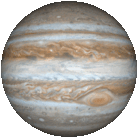 Outreach
Outreach CV
CV